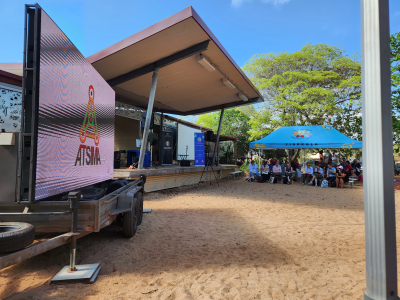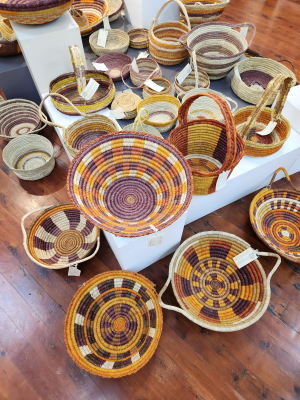Going to the ATSIMA 2023 conference
The Statistical Society of Australia (SSA) were advertising funding to support a member to attend this year’s Aboriginal and Torres Strait Islander Mathematics Alliance (ATSIMA) conference. I’d been wanting to go to an ATSIMA conference for a couple of years so when this funding came up I jumped at the chance - and luckily enough for me I got it! So a big thank you to the SSA for enabling me to attend the conference.
I wrote some reflections each evening of the happenings each day. If you have an opportunity to attend an ATSIMA conference you should unreservedly pursue it. This conference has been like no other, the atmosphere was one of openness, kindness, and a genuine desire to learn from each other and do better when it comes to teaching Indigenous kids (and children more broadly!).
Day 0
Since having an infant I’ve become accustomed to waking up at 5am, but it felt like a bit of a stretch waking up at 4am this time. But you do what you’ve got to do! Funnily enough, they woke me up one minute before the alarm was due to go off anyway, so thanks for the help Billie.
So up at 4am, dressed, packed, coffeeed, breakfasted, and dropped off at the bus station. Off to a good start! The plane was delayed by 45 minutes, which was a little alarming given there was only an hour in the original schedule to transfer. When we touched down in Cairns I walked briskly to the connecting gate, only to find they hadn’t even opened boarding yet. I relaxed for a moment then realised I’d put my t-shirt on inside-out. Serves me right for getting dressed at 4am in the dark!
A big line had formed by the time the flight to Gove finally opened. Lots of delegates attending the ATSIMA conference this year! We boarded, only to find out we were now waiting for another flight that had been delayed. All my worries about being on time for naught! No matter though, the flight eventually departed and we landed in Gove airport.
What a sight to behold, the red dirt of East Arnhem land. The land is beautiful up here.

Day 1
What a day! I’m sitting back in my room with a thoroughly sunburned neck and a head full of ideas. It’s been fascinating coming to a conference that’s heavily focused on teaching. I have no background in teaching (besides learning vicariously through my partner’s teaching degree), so it was great to listen in on the conversations people were having about teaching. The language they use was quite different to what I’d hear on a day to day basis - I heard pedagogy several times.

The day started out with a Welcome to Country from local Elders, followed by Professor Chris Matthews and a panel of speakers talking about Garma Mathematics and two-way learning - meaning to teach in a way that incorporates both Western and Indigenous ways of knowing and being and treats them as equal. Then Yingiya Mark Guyala MLA told us part of his story, going from living on his homeland and getting a practical education from his Elders, through going to school and learning English, to getting his pilot’s license. He talked about how learning the balanda (the Yolgnu word for Western people) way was pulling him in one direction, and learning the Yolgnu way pulling him in the opposite, to the point where he couldn’t keep going. His story really drove home the importance of figuring out how to bring Western and Indigenous teaching together.

In the push against the deficit narrative that so often accompanies how Indigenous people’s lives are talked about, a strengths-based approach that sees Indigenous cultures and communities as a strength is something I often come across. And while this approach is something I agree with and try to incorporate into my own writing, I feel like I’ve only known it at a factual/intellectual level. Today really changed that for me though. I heard so many stories about the brilliance of Indigenous children, how they engaged and learned about mathematical topics typically considered ‘beyond’ the usual capabilities for their age, and this was all possible through their culture. The ‘complex’ mathematics were part of their lives, part of their culture, it just took making the connection between what they already knew and the specific mathematics.
We finished off the day with food, chatting, checking out the art gallery, and hanging out with the camp dogs.

Day 2
In one of the sessions I had my first experience with a virtual reality (VR) headset, boy are they COOL. The workshop was a demonstration of a rapid design challenge the presenters run with children. We had to design come up with our own design of a fish net or trap, similar to those made by Indigenous cultures across Australia. Our group decided to make a crocodile catcher, and after a brief few minutes sketching some 2D designs on paper we were thrust into three dimensions via the VR headset.

I also listened to a couple of presentations how culture can be woven into specific high school educational settings. The theme of yesterday came through again, that Indigenous culture(s) are such a source of strength and engagement in the classroom, even for non-Indigenous kids. We later heard from a group of teachers from the East Arnhem region who talked about the importance of teaching in language (Yolngu for the kids here). For the majority of the children, Yolngu matha is their first language, English is something they learned later. So while it might seem obvious to teach children in the language they know best, apparently it wasn’t obvious to everyone. But after teaching mathematics in their language and linking mathematical concepts to cultural ideas they were familiar with, the kids were more engaged and learned mathematical concepts more readily. One of the quotes that stuck with me too was that “Yolngu parents want their children to succeed, but not at the expense of their culture”, this point once again reaffirming the importance of incorporating Indigenous culture in teaching Indigenous children.
The talks finished at 3pm today and we went on a cultural walk through a trail down to a nearby beach. Some of the local kids and rangers explained various plants and their uses as we walked the trail. After passing an unusually angular arrangement of branches, we made it down to a secluded beach with beautiful views across the ocean.

The conference dinner was the final event of the evening, we shared food and conversation and were entertained by the Andrew Gurruwiwi band. If you haven’t listened to the band before, I highly recommend you check them out!
Day 3
The final day was largely dedicated to summarising the key themes we’d covered in the previous two days. We got together in groups of approximately ten to have a yarn about the topics we’d heard at the conference and what we were going to do going forward. It was such a brilliant way to round out a conference. In previous conferences I’ve been to you go to the talks you’re interested in but you effectively miss out on the other sessions you don’t attend. While there might be conference abstracts, you’re left to read them in your own time and reach out to the authors if you want more detail.
By getting everyone together and encouraging them to form groups with people they might not have met or know well, we all got to learn more deeply about the conversations had throughout the conference. Then at the end, each group got up and gave a summary of their yarn so everyone could learn. It was such a beautiful way to make sure that nobody missed out on the learnings made at the conference. I wish more conferences would do it!

One of the themes that really struck a chord with me was the importance of giving back to the Indigenous communities that give their knowledge, knowledge used to develop materials used to teach kids. Schools which have the ability to work with local communities to incorporate their knowledge into the curriculum must make sure that the material they develop is available to everyone. Many of the teachers present were from schools were there were only a few Indigenous students, so the materials mostly benefited non-Indigenous children. Making the resources more broadly available, in particular to other schools where more Indigenous children might be present, means the knowledge of the community can be benefiting as many Indigenous children as possible and help their learning and connection to culture.
The reason why this struck a chord with me is because I realised I need to do more of this in my PhD. Up until now I’d been doing research translation back our policy and community reference groups, but the research I’d done was at a broad population level. The communities want to know what the data says about their specific contexts, so I intend to shift my direction to do more community-disaggregated analysis, that’s directly relevant for these communities.
Day 4
The conference had ended, but the conversations continued at the airport. We’d all gotten to know each other so well over the past few days and there are only a handful of flights out of Gove each day, so naturally we all congregated at the terminal and kept the conference chatter alive for an extra hour or two. While I can only speak for myself, I imagine every single attendee of ATSIMA2023 is grateful to Professor Chris Matthews, Melinda Pearson, Caty Morris, and everyone else who put so much work in to make such an incredible conference happen.